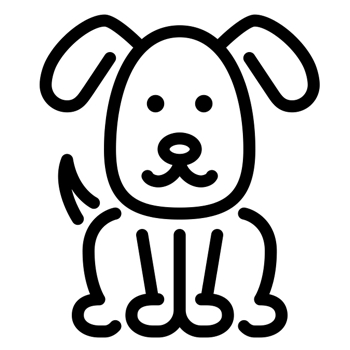Weshi

The Weshi is the quintessential designer dog that is small, fluffy and a whole lot of fun. They were first bred in the United States and incorporate the loyal and loving Shih Tzu with the self-assured and lively West Highland White Terrier. Ideal for young families and the elderly alike, this confident little dog thrives when in the company of people and will dedicate itself to its owner wholeheartedly.
Petite and fluffy with an attractive face and intelligent, brown eyes, the Weshi will capture the heart of everyone it meets. Their coat is wavy and long and usually a mix of black, white and grey. Short and stocky, they are more robust than they first seem and can put up with more rough and tumble than similarly-sized, finer-boned dogs, such as Chihuahuas and Papillons.
About & History
Also known as the Westie Tzu, the Weshi is thought to have been developed in the States around 30 to 40 years ago. This was the ‘boom’ time for designer dogs and families all over the world were seeking the ‘perfect pet’, with smaller, hypoallergenic options being snapped up.
The Shih Tzu
Shih Tzus are oriental dogs that hail from either Tibet or China and are known to be one of the truly ancient dog breeds. Also known as ‘lion dogs’, they have been regarded as faithful companions for many hundreds of years. It is likely that they share a similar genetic makeup to the Lhasa Apso and Pekingese, who also come from the Far East.
Shih Tzus are known to have had close ties with monks and many resources suggest they may have even been kept as ‘temple dogs’. The breed was only exported to Europe at the start of the 20th century but their popularity has steadily increased all around the world since then and they are now one of the most well-known pet and show dogs internationally.
The West Highland White Terrier
West Highland Terriers, or Westies for short, were one of the most popular dog breeds a decade or two ago but have largely fallen out of favour due partly to the chronic skin issues that often plague them and partly to the rise of the designer dog (such as the Weshi!).
They are a Scottish breed with a characteristic white coat and they would have originally been used to hunt small prey. Their tenacious attitude certainly lends itself well to this pursuit and even the Westies of today will have a rather high prey drive. Before the 20th century, the Westie was known as the Poltalloch Terrier.
Appearance
Cute as a button, the Weshi has a sweet face with an alert expression. Their ears tend to flop forwards and are held up high on their skull. They have circular brown eyes and a well-defined stop. Their muzzle is quite square and they should not have either an over or under shot jaw. They have robust little bodies with sturdy legs that may be slightly bowed. Their tail is medium in length and might have a curve at the tip, as well as some feathering.
An adult Weshi weighs from 5kg to 7kg and, when measured to the withers, should reach heights of about 28cm. While the coat of the Weshi rarely reaches the impressive length of the Shih Tzu, it should be noticeably longer than that of their Westie parent. Some dogs retain the characteristic white fur of the Westie while others may be brown, grey or black. The majority will have at least some white on their fur.
Character & Temperament
Brimming with confidence and bravado, even a young Weshi will feel comfortable in its own skin and won’t have any issues standing up for itself and securing its place in the family home. It is important to not let this bolshy dog get too bigheaded as this can result in issues with their training and may even lead to ‘small dog syndrome’. As long as there are firm and fair house rules from the get go, there shouldn’t be any issues.
Dogs who will absolutely adore their owners, they form very close bonds with their family and tend to choose one individual as their ‘favourite’ (usually the person they spend most time with). This reliance on companionship can be a double-edged sword as some Weshis will develop separation anxiety if their owner needs to be out of the house for long periods of time.
Some breed members can be ‘yappy and snappy’ especially when in the first year and the last years of their lives. While they can get on very well with children, it is best to always watch them closely. Naturally playful, they will enjoy partaking in games and feeling part of the family.
Trainability
Though there is no doubting the intelligence of the Weshi, many are stubborn and will typically question a training cue rather than jumping right in. This can be largely overcome with repetition and high value rewards. Some individuals are more stubborn than others and it can be useful seeking outside advice from a qualified behaviourist for those dogs who are not responding to their training as expected.
Health
Pedigree dogs have received a bad rap in recent years as it has emerged that many are more prone to long-term medical issues than their mixed-breed counterparts. As the Weshi is only one generation down from two of some of the more ‘unhealthy’ breeds out there, it is no surprise that we see several health conditions cropping up in this hybrid.
Brachycephalic Upper Airway Syndrome (BUAS)
Whether or not the Weshi develops BUAS will depend on the physical characteristics it inherits and its eventual conformation. Affected dogs may have issues, including small nostrils and long soft palates, which can greatly impede their breathing and ability to exercise. The worst affected individuals may well benefit from corrective surgery.
Atopic Dermatitis
Atopy is also called ‘itchy skin disease’ or ‘allergic skin disease’ and it causes chronic itching, which invariably leads to scratching, broken skin and secondary infections. Dogs may react to things in their environment, such as moulds and pollens, or to ingredients in their food, such as chicken or peas.
While the signs can usually be managed with topical and systemic medication, it is useful to determine what a dog is reacting to by performing allergy testing. In some cases, a course of immunotherapy can help dramatically.
Mitral Valve Disease (MVD)
The most common degenerative heart disease in smaller dogs, MVD typically affects dogs older than 7. Initial signs may include coughing, a reduced interest in exercise and excessive panting. On exam, a vet may hear a murmur and imaging tools, such as x-rays and ultrasound machines, can be used to diagnose this disorder. Many patients can be well managed for years on medication.
Intervertebral Disc Disease (IVDD)
IVDD tends to occur in those small dogs with the longest backs. To minimise the risk of IVDD, owners should work hard to ensure their dog does not become overweight. It is also sensible to walk them on a harness and to avoid steps, stairs and jumps as much as is possible.
Portosystemic Shunt
Liver shunts tend to result in a puppy that fails to thrive and is dramatically smaller than its littermates. Other symptoms can include nausea, diarrhoea and even seizures. Some shunts are easily detected on an ultrasound scan, while others may require more detailed imaging studies. Once patients are stable enough, a surgery can be performed to correct the defect.
Exercise and Activity Levels
To the delight of many owners, the Weshi does not have tremendously high exercise requirements and is usually content with two twenty to thirty-minute walks a day. Many will make excellent lap dogs once they have burned off some steam!
Care must be taken in smaller-nosed Weshis who can find it hard to breathe efficiently in hot and humid weather. On warmer days, exercise them closer to dawn and dusk and stick to the shade.
Grooming
Though not as high maintenance as Shih Tzus, the Weshi still needs plenty of attention when it comes to keeping them looking good. Owners should brush their coat every day to keep on top of any tangles or mats. Those with blocked or narrow tear ducts may need their tear staining cleaned and dried each morning. To minimise the risk of dental disease, daily tooth brushing is also recommended.

